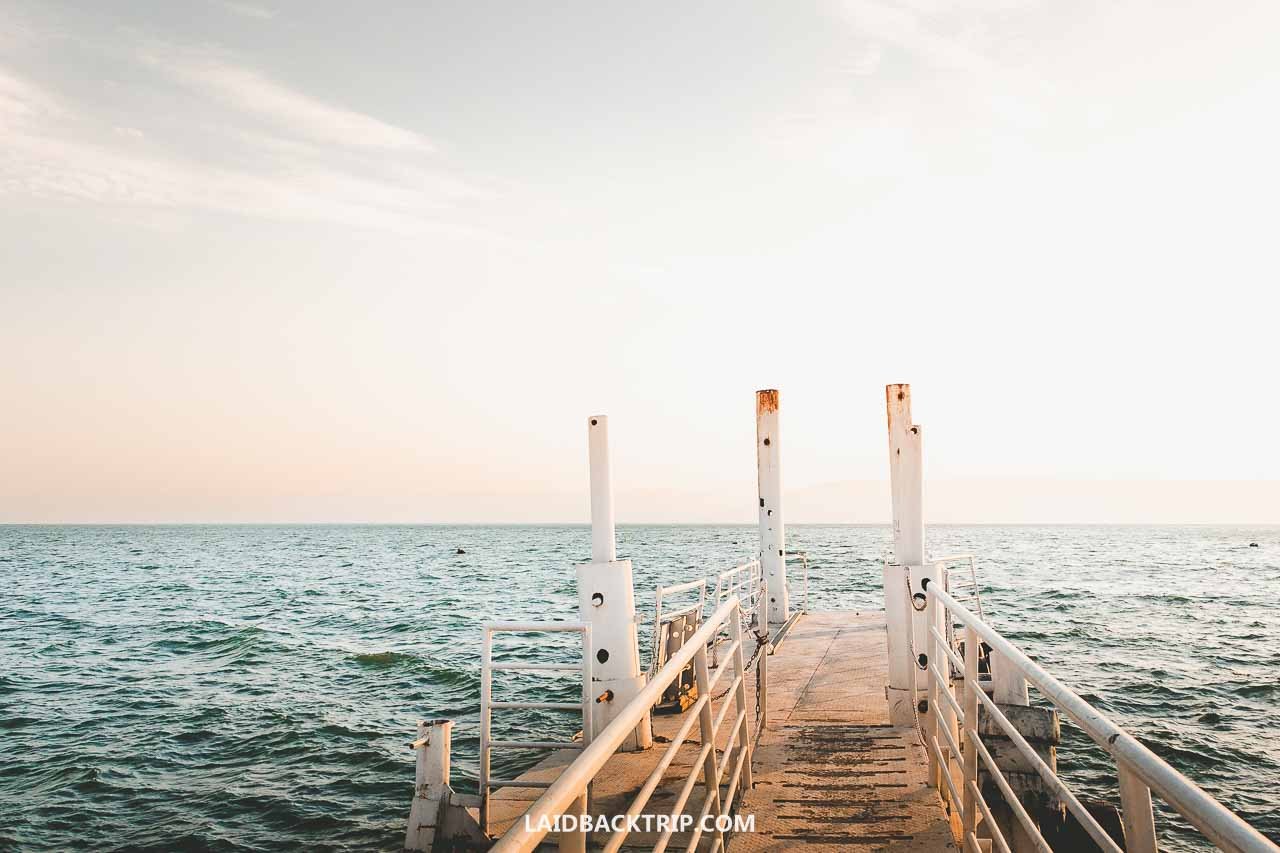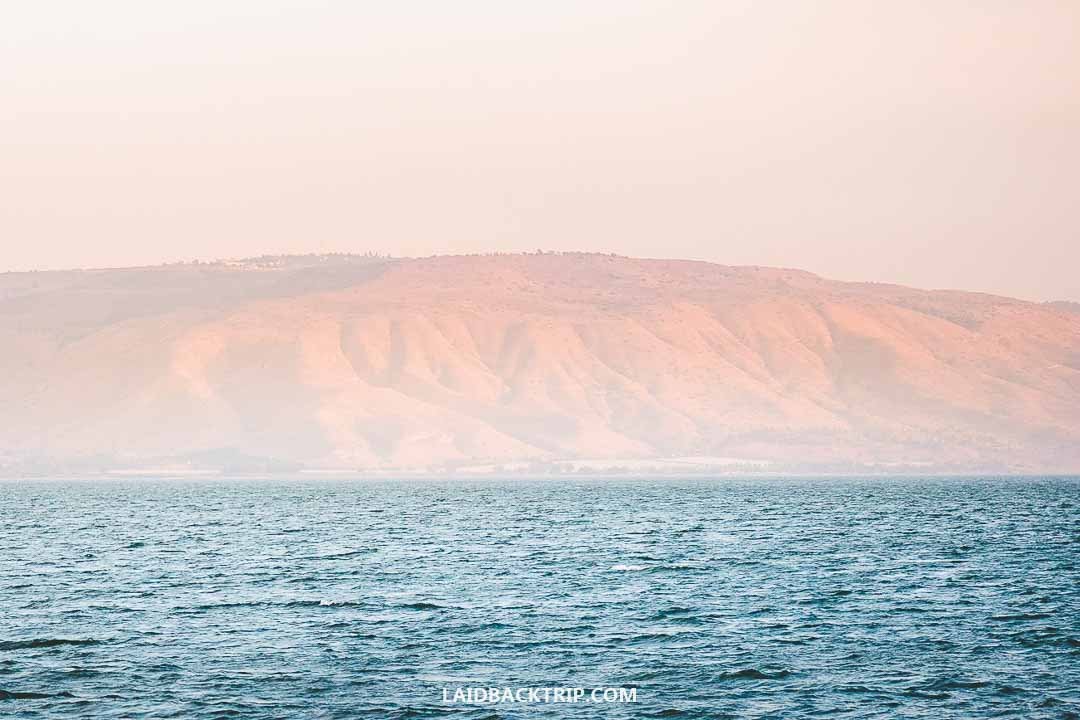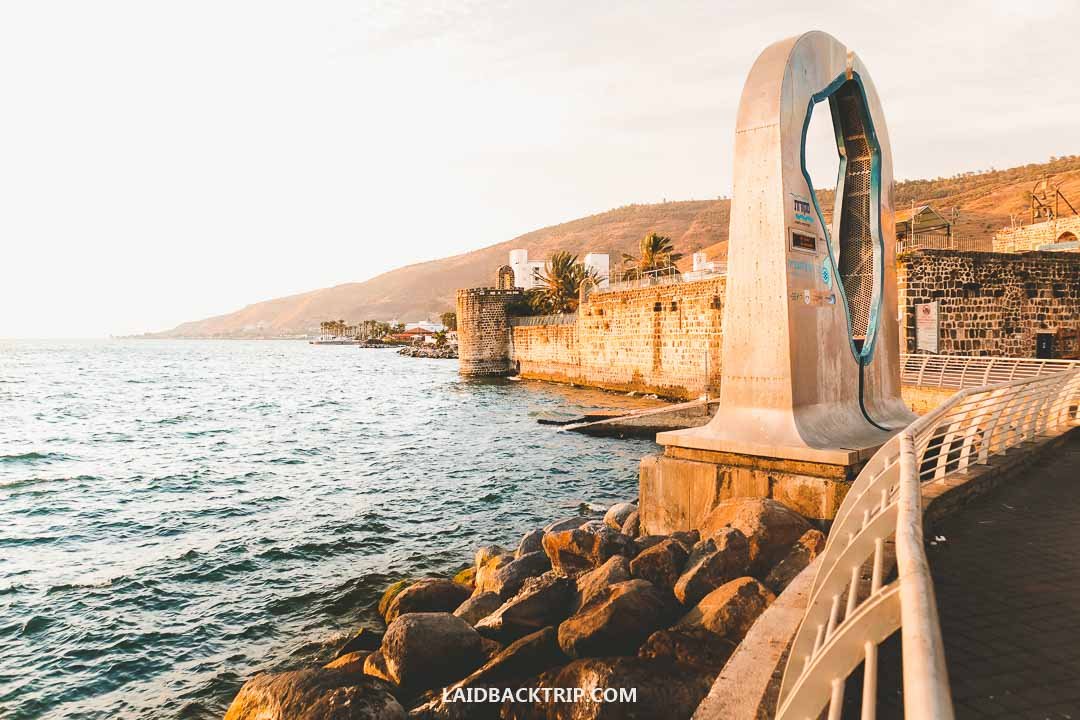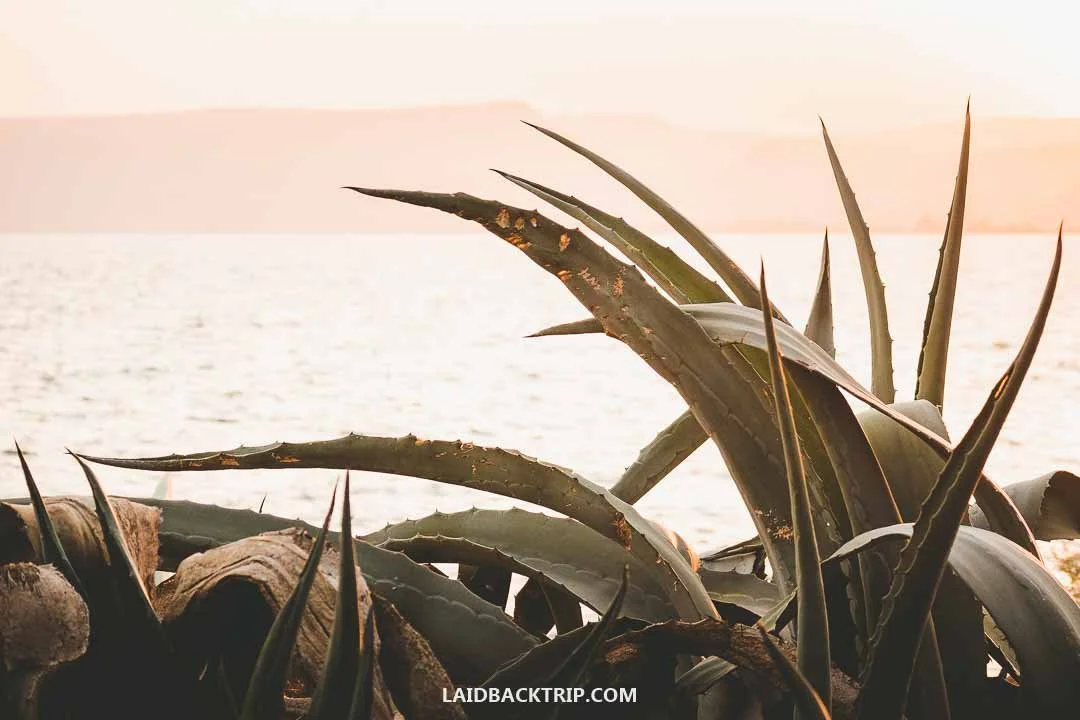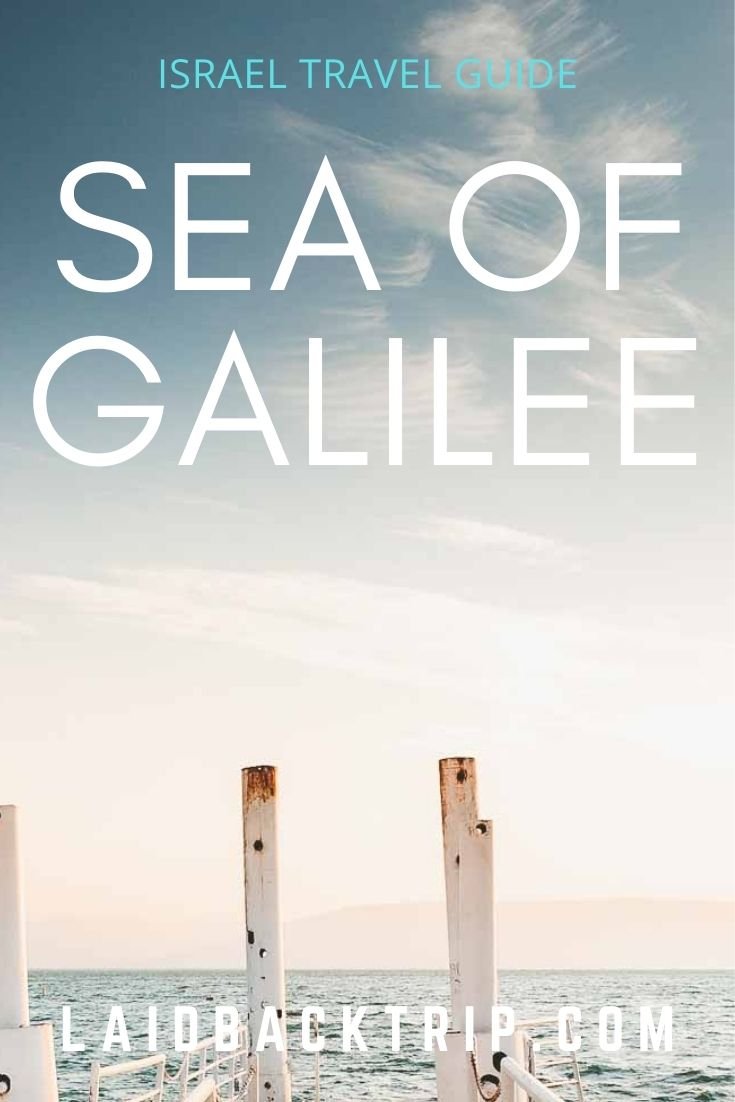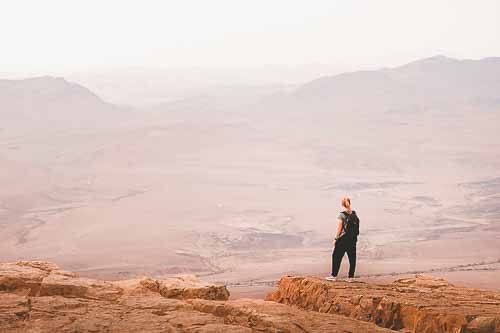The Ultimate Guide to the Sea of Galilee in Israel
Read our travel guide on the Sea of Galilee (also known as Lake Tiberias or Lake Kinnereth) in Israel. Includes best things to do in the area, top attractions, when to go, where to stay, and more travel tips.
Sea of Galilee in the northeast of Israel is one of the top travel destinations in the country for many reasons.
Whether you come to follow the life and footsteps of Jesus, visit one of the four holy Jewish towns, lie on the beach or just experience incredible scenery, the Sea of Galilee shouldn't be missing from your Israel itinerary.
For some reason, we believe that your trip to Israel wouldn't be complete without visiting the Sea of Galilee.
Even if it should be a short trip and you should just get a glimpse of this sparkling (and important) body of water.
Hopefully, we might find some valid reasons together somewhere in the following lines that should inspire you to travel to this area.
Or, maybe we'll just discover that the Sea of Galilee is just a sizeable blue-colored lake where there's nothing worthwhile to see and do.
Let's find out, but we'll give you a small hint, we are supporters of the first concept.
So, here's everything you should know about the Sea of Galilee before you go.
Things to Know About the Sea of Galilee
Sea of Galilee is an important water basin in northern Israel, and we believe a short introduction is appropriate here.
The Jordan River is the primary water source of the Sea of Galilee, but some underground springs help keep the water level in balance.
Despite its name, the Sea of Galilee is a freshwater lake.
When searching for information about the lake, you might come across names such as Lake Tiberias, Kinneret, or Kinnereth Lake, but they all mean the same place, the Sea of Galilee.
Sitting at the altitude of 200 meters below sea level, the Sea of Galilee is the second-lowest lake in the world after the Dead Sea, which is, however, a saltwater lake.
What to See and Do in the Sea of Galilee
The Sea of Galilee is often presented as a destination appreciated only by religious visitors. And that's not very surprising, considering how many biblical sites and landmarks you can find there.
But the Sea of Galilee is also a top holiday destination for locals and offers much more than that.
Whether you love beaches, cycling, walking, hiking, or nightlife, you can find all that and much more there.
To make this article more user-friendly and clear, we're going to start our journey around the lake in Tiberias.
Therefore, we listed all the top attractions, towns, and landmarks as you would visit them when driving around the lake in the counter-clockwise direction.
Driving Around the Sea of Galilee
Before we dive into the section that includes all the must-see places in the Sea of Galilee, we must first stop briefly at the driving part.
While you can bike or even walk around the lake, we decided to get around by car as we also wanted to visit some other sites that are not exactly on the lake's shores.
If you're wondering in which direction to travel around the lake, then note that it makes almost no difference unless you're short on time.
Most of the must-see places are located between the western and northern areas of the lake. It means that you don't need to exactly encircle the entire lake to see the best of the Sea of Galilee.
Lastly, making a complete loop when driving around the lake is unnecessary if you're short on time or all places don't fit your travel itinerary.
However, you might miss out on some interesting sites, so it makes sense to decide whether a short detour is worth your time or not.
For example, if you're going from Safed to Nazareth, the planning part is far easier than when traveling from Safed to Beit Shean.
Ultimately, the entire lake is not that large, and most of the detours won't take up a lot of time.
Tiberias
Tiberias is a heavy caliber for people who are unfamiliar with its history or didn't google any images of the city back home.
Tiberias underwent in the 1970s rapid development, and we can see the concrete results that dominate the town to this day, no pun intended.
The architecture style might be a bit aggressive, but it's what it is, and honestly, we've seen worse.
So what is there to do and see in Tiberias?
Tiberias has some tombs of Jewish sages, a waterfront Yigal-Alon Promenade, a Sea Mosque, Saint Peter's Church, or an open archaeological park.
The city has a large Jewish ultra-Orthodox community, hot springs, and plenty of restaurants and hotels.
All this makes it quite an interesting bag of emotions, and we believe that everyone should make a stop there, even if it's just for a couple of hours.
It's a typical vacation destination similar to Eilat in some sense, so we would stay away during the summer and national holidays as it can be crowded.
Mount Arbel
While we couldn't wish for better weather while road tripping Israel, the views were sometimes limited due to the strong haze.
We barely had seen the lake on our way from Akko to Safed a few days ago.
And when we were facing similar weather once we arrived in the Sea of Galilee, we decided not to climb to the cliffs of Mount Arbel as we already knew that the proclaimed spectacular views wouldn't be worth it this time.
It was a shame as we love hiking and the views of the lake from the top are hard to beat, but that's life.
Nevertheless, if you're ready to tackle the 181-meter high mountain to get some epic views, then you won't find here a better opportunity than Mount Arbel.
It's only fair that we should add here that the hike to the mountain that's also mentioned in the Bible is a bit harder than we've let you think.
Due to the fact that the surface of the lake lies actually a couple of hundred meters below sea level, the mountain, in reality, rises almost four hundred meters above the Sea of Galilee.
To make it up to you for our tiny deception, we have to mention that the main entrance in the west is only a ten-minute walk from the top, so you can use this one if you are not feeling up to the challenge.
While the views are hard to beat, there is also Arbel Fortress carved in the steep cliffs of the mountain and a 4th-century ancient synagogue about two kilometers west of the top.
By the way, we visited Israel in November and experienced hazy conditions also in Mount Tabor, Masada (where we hiked the Snake Path Trail) or Avdat National Park.
Mount Beatitudes
While it would be tempting to go directly to Tabgha, we will stay on Highway 90 and drive to Mount Beatitudes first.
Stay on the road for two and a half kilometers, and then turn right onto narrow Road 8177, which will take you to the parking lot in front of the Beatitude Monastery.
Mount Beatitudes is believed to be a place where Jesus gave the Sermon on the Mount. Also known as Mount Eresmos, the mountain (more like a hill) is located above the Capernaum and Tabgha.
While the Bible doesn't specifically name the places of the sermon's location, Mount Beatitudes has been considered the place since the 4th century CE when the first pilgrims started visiting it.
A Roman Catholic Franciscan Chapel was built near the original remains of the original Byzantine Church that was used from the 4th to 7th century.
Today, the site is popular with Christian pilgrims who come here for obvious reasons, but even non-believers can enjoy the stunning views of the Sea of Galilee from the top.
Tabgha
Once you soak in the views of the Sea of Galilee and the surrounding scenery, return to the main intersection near the lake, turn left onto Highway 87 and stay on it for less than a minute until you reach the Tabgha junction.
Tabgha is another place where Jesus, according to the gospels, performed another of his miracles.
Feeding the multitude is also known as feeding the 5000 and feeding the 4000.
Providing the hungry by multiplying the bread loaves and fishes is regarded as two separate miracles, which explains the two different numbers.
Moreover, it's the place of the fourth appearance of Jesus after his crucifixion and also a place where Jesus made Peter the head of the Apostles.
There are two churches in the area - Church of the Multiplication and the Church of the Primacy of Saint Peter. Both are usually open from 8 AM to 5 PM, and the entry is free.
As you can clearly see, it's not surprising that Tabgha is a popular stop on the pilgrimage route.
Capernaum
One of the must-visit sites for Christians in the Sea of Galilee, Capernaum, used to be the home of Jesus.
After the local community rejected his ideas in Nazareth, he moved to this small fishing village on the lake's northern shore.
Jesus did his ministry in Capernaum and performed several of his miracles here. From all the biblical sites in the Sea of Galilee, Capernaum is probably the most important one.
Today, a modern saucer-shaped church stands above the alleged location of Peter's House.
Just a few steps to the left stands the remains of a White Synagogue that also hides the Ancient Synagogue, where Jesus could preach.
This area also features a Greek-Orthodox Church and a Kfar Nahum National Park.
The former has some beautiful paintings inside the building, and the latter has a pier where you can take a boat ride or just walk along the shore.
It's hard to choose which Christian sites are worth visiting for non-Christian visitors or which to see if you have time just for one place.
Nevertheless, we would say that Capernaum is arguably the one you should include in your travel itinerary regardless of your personal beliefs.
By the way, Capernaum is less than three kilometers east of Tabgha.
Duga Beach
Finding a lovely, quiet, clean beach is not easy in the Sea of Galilee. Even though there are plenty of them, the local authorities have neglected them for years.
However, this has changed recently, and some were designated as quiet zones.
One of them is Duga Beach, located in the northeast of the lake, about 15 kilometers east of Capernaum. Don't forget to turn left onto Highway 92 at the Yehudiya Junction.
Duga Beach was recently renovated, and it's arguably the best beach in the Sea of Galilee at the moment.
It has lawns, tent areas, playgrounds for kids, bathrooms, showers, and offers easy access to the lake. The beach can get busy on weekends and holidays.
There is no entrance fee to Duga Beach, but you need to pay for the parking.
Kursi National Park
According to tradition, today, Kursi National Park is the site of Jesus's Miracle of the Swine.
And for many Christians, it's another place they should see on their pilgrimage. It's less than four kilometers south of Duga Beach, so you will get there in no time (or six minutes).
Kursi National Park is a tiny area containing the ruins of the Byzantine Monastery with a mosaic or remains of the Late Roman period bathhouse.
There is not much to see and do for non-Christian visitors, but as it's a less-traveled place, it's easy to avoid the crowds here.
The entrance fee is 12 NIS ($4), and they accept the Israel Pass.
Ein Gev
Ein Gev is a small kibbutz with a population of 700 on the eastern side of the Sea of Galilee.
Staying in a local kibbutz is an exciting experience while you're in Israel, and you will hardly find a better-located one than the Ein Gev.
Today, the kibbutz focuses not only on agriculture but also on tourism, meaning you can find Ein Gev Holiday Resort and a fish restaurant here.
Ein Gev is six kilometers south of Kursi National Park.
Tzemach Beach
Tzemach Beach lies at the southernmost tip of the Sea of Galilee, and it's another excellent sandy/rocky strip in this area.
Like Duga Beach in the north, Tzemach Beach is a clean and tidy place popular with families with kids.
Admission is free, and the parking is across the street in front of the large shopping mall.
The beach lies about 12 kilometers southwest of Ein Gev.
From here, you can continue back to Tiberias and finish the loop, or head south to Beit Shean, home to some incredible Roman and Byzantine structures.
Hamat Tiberias National Park
Located only three kilometers south of Tiberias, Hamat National Park is a small yet worthwhile place to visit.
Like Beit Alfa Synagogue, the 2nd century CE Severus Synagogue features an impressive three-paneled mosaic with a Zodiac in the middle, which is today housed in an air-conditioned building.
There are a few more ancient structures, such as Roman period baths, but the hot springs you can wade in steal the show.
Note that above the national park is a Tomb of Rabbi Meir, which is one of the must-visit places for all Jewish people.
And about a couple of hundred meters north of here is Tiberias Hot Spring, which should visit everyone who loves hot springs or spa treatments.
We don't have to mention that it's best visited on a rainy day during one of the colder winter days.
The entrance fee to Hamat Tiberias National Park is 14 NIS ($4), and they do accept Israel Pass.
Top Activities to Do at the Sea of Galilee
Hiking and biking are popular activities to do at Lake Kinneret. Be prepared that the extreme summer temperatures make all outdoor activities more challenging.
Make sure to bring plenty of water with you to stay hydrated throughout your entire adventure.
There are two major hiking trails in the Sea of Galilee, but you can find plenty of short hikes in this area as well.
Jesus Trail
A 65-kilometer Jesus Trail starts in Nazareth and goes through Tzipori National Park, Cana, the Horns of Hattin, Mount Arbel, Capernaum, Tabgha, and the Mount of Beatitudes, connecting the major pilgrimage sites in Galilee.
If you're visiting Israel on a budget, hiking is one of the best ways to do so.
Sea of Galilee Trail
The 60-kilometer Sea of Galilee Trail encircles the lake and might be a great alternative to a regular road trip or a more challenging Jesus Trail.
The trail is easy to moderately difficult, depending on your fitness level and current weather conditions.
Biking
If you prefer to stay active during your vacations, you can consider renting a bike in your accommodation and cycling around the Sea of Galilee.
The 60-kilometer trail is not difficult, but it usually takes more time to complete the entire loop than the estimated times.
The trail that circumnavigates the Sea of Galilee is one of the most popular ones in entire Israel, so take your time and enjoy the lovely scenery around you.
Water Activities
From lazing around on the beach, swimming, boat trips, motorboat rentals, banana boat rides to wakeboarding or water skiing, the Sea of Galilee is no short of fun activities.
Tiberias is an excellent place to start when searching for rentals or tours, but many beaches scattered around the shoreline offer them too.
Be prepared that some of the water activities at Lake Tiberias are not exactly budget-friendly.
Staying Safe
Sea of Galilee is a popular travel destination and is considered safe to visit, despite its relative proximity to the Golan Heights.
Staying safe in Israel requires a bit of effort from your side, so it's better to know what to expect before you go.
Travel Insurance
We never leave home without travel insurance that was designed to cover our expenses if something goes wrong during the trip.
Travel insurance protects against theft, flight delays, injury, illness, cancellations, and much more.
World Nomads provides travel insurance for travelers to cover their trip essentials, including sports and adventure activities.
SafetyWing is affordable travel insurance for backpackers, long-term travelers, and digital nomads.
Travel smarter and safer!
How to Get Around
As mentioned above, the easiest way to get around the Sea of Galilee is by car.
While it's easy to get to Tiberias by bus from pretty much every corner of Israel, the same cannot be said about exploring the Sea of Galilee by public transport.
It's not that's impossible. It's just that it would require a lot of time and effort to plan the trip sensibly.
The buses run in the Sea of Galilee irregularly, but the bigger problem is that they don't connect the tourist sites.
You can also hire a driver for a day. Just be prepared that it can be pricey, so it's better to travel in a group to split the cost of travel.
Or you can take a guided tour that visits the top attractions without worrying about arranging your own transport.
Tours are an excellent way to see as many places as possible in a short time, and knowledgeable guides will ensure that you will get the most of your trip.
Lastly, hiking and biking are great alternatives to driving around the lake, but you need at least an extra day or two to enjoy the trip.
How to Get There
If you have a car, it's straightforward to get to the Sea of Galilee regardless of your location.
Driving in Israel is easy, so make sure to read our post on this topic to learn more.
While it's easy to get to Tiberias by bus, the problem arises once you want to get around the lake. Therefore, we believe it’s better to have a car.
Here you can find the best deals on rental cars in Israel.
Car
Tiberias is about 180 kilometers north of Jerusalem via Highway 6, but if you decide to drive via Highway 90, the journey of 150 kilometers to the south tip of the lake might be a better alternative.
Highway 90 goes via the West Bank, but only through the territory that's under full Israeli control, so it should be safe.
However, always make sure that the current situation hasn't changed recently and that your rental car is allowed to enter this area.
Highway 6 is the main road in Israel connecting the north with the south but be prepared that it uses an electronic toll system, meaning it's not free.
The direct drive between Tiberias and Tel Aviv via Highway 6 is 140 kilometers and should have a drive time of two hours, depending on the traffic.
Tiberias is the gateway to the Sea of Galilee, and that's where you should be heading first when arriving by public transport.
Safed is less than 30 kilometers northwest of Capernaum, so it shouldn't take you more than 30 minutes to get there.
The 20-kilometer drive from Rosh Pinna and this biblical site can be covered in twenty minutes.
Nazareth is 30 kilometers west of Tiberias, and if you continue west, you will need to add another 30 kilometers to reach Haifa or Akko on the Mediterranean Sea coast.
Bus
Getting to Tiberias by public transport is very easy from most of Israel.
Bus 31, 38, and 431 runs between Nazareth and Tiberias. Bus 955 (Egged) connects Jerusalem and Tiberias, and the journey takes about two and a half hours.
Similarly, bus 836 (Egged) runs frequently from Tel Aviv to Tiberias.
Here you will find more information on how to get around Israel.
Tours
There is a large selection of Sea of Galilee tours to choose from, so pick the one that fits your preferences and travel itinerary.
Nazareth, Tiberias, and Sea of Galilee Day Trip from Tel Aviv | Explore the important biblical sites in Nazareth, Tiberias, and the Sea of Galilee areas, such as Capernaum, Tabgha, or Mount of Beatitudes on a day trip from Tel Aviv.
Nazareth, Tiberias, and Sea of Galilee Tour from Jerusalem | This well-rated tour shares a very similar itinerary as the one above - Nazareth, Tiberias, Sea of Galilee, Capernaum, Tabgha - but leaves from Jerusalem.
Where to Stay
The Sea of Galilee features many hotels for all types of travelers, but as the lake is pretty large, you might wonder where the best area to stay overnight is.
Basically, you have two options, staying in Tiberias or the countryside.
Tiberias is the largest town on the lake's shores, and that's where you'll find the largest selection of hotels.
Hotels in Tiberias range from cheap(ish) hostels to luxury resorts, so it's pretty easy to find a room that fits your needs there.
But Tiberias can be hectic, busy, and precisely a peaceful oasis you might be looking for when searching for accommodation.
Don't worry; there are plenty of other guesthouses, family-owned cabins, or resorts outside Tiberias scattered around the entire Sea of Galilee.
In this case, the location will play the most vital role in your search for accommodation. Therefore, pick the hotel located somewhere along the route you've planned.
Khirbet Minim | HI Karei Deshe Hostel - If you're traveling on a budget, then the HI Karei Deshe Hostel might be a perfect choice for you. Situated in the northwest corner of the Sea of Galilee, this hostel has an excellent location close to major tourist sites in this area. Rooms are air-conditioned, clean, spacious, affordable, and breakfast is included in the price. Plus you can walk to the beach in three minutes.
Ein Gev | Ein Gev Holiday Resort - Located on the east shore of the Sea of Galilee, Ein Gev Holiday Resort is one of the best mid-range hotels in the area. This family-friendly hotel features a quiet location, free on-site parking, rich breakfast, and immaculate rooms.
Tiberias | Scots Hotel - If you prefer to stay in something a bit more lavish, the Scots Hotel should be on your radar. Set in a historical building of a former hospital with two wings, this luxury hotel features a beautiful garden, comfortable beds, a swimming pool, and a gourmet restaurant.
How Many Days for the Sea of Galilee
In our opinion, you should allow yourself a whole day for the Sea of Galilee.
We decided to stay in Tiberias overnight to split our trip into two half days, but that depends on your travel itinerary and what time you reach the lake's shores.
If you don't plan to visit most sites, then note that encircling the entire lake shouldn't take you more than an hour and a half.
When to Go
Arguably the best time to visit the Sea of Galilee is in the spring or autumn as the weather is a bit cooler than in summer.
Summer in the Sea of Galilee is very hot and humid. The average temperature here in July and August is almost 30 Celsius which makes traveling quite challenging during this period.
Most travelers with common sense avoid this time of the year as other areas such as the Negev Desert or the Dead Sea share similar features.
However, if you live in the Southern Hemisphere, let's say in New Zealand or Australia, and are looking for an exciting holiday destination, this might be your chance to warm up your joints during the winter.
Winter in the Sea of Galilee is warmer than places situated in higher elevations such as Safed or Jerusalem but be prepared that it's a bit rainier during this period.
For more information on this topic, read our guide on the best time to visit Israel.
What to Pack
As mentioned above, the scorching summers can make exploring the Sea of Galilee a bit more difficult if you come unprepared.
Fortunately, the only three essential things you need to fight the unpleasant weather conditions are a hat, sunscreen, and a water bottle with plenty of water.
The Christian holy sites require modest clothing, but the rules are not as strict as in Muslim's Dome of the Rock.
Make sure to cover your shoulders, and wear thin and lightweight pants or a long skirt.
On the other hand, there are several beaches, and even hot springs so don't forget to pack your swimsuit with you.
We also lazed around the beaches in Tel Aviv, swam in the Dead Sea, waded in the streams of Ein Gedi, or snorkeled in the Red Sea, so there are plenty of opportunities to use the swimwear throughout your entire trip.
If you plan to do a lot of walking, wear comfy runners and carry a comfortable daypack.
And don't leave your travel camera at home.
Is It Worth Visiting the Sea of Galilee?
It comes without a surprise when we say that the Sea of Galilee is worth visiting. Due to our curious souls, we love exploring new places even if they don't exactly tick all the right boxes.
But that's one of the reasons why we enjoy traveling so much. To see something new or learn something unique about the world.
Some travelers might convey that the Sea of Galilee is monotonous, that only religious people can enjoy it, or that some areas are neglected, and Tiberias is outright hideous.
If you arrive here with this mindset, then the chances are that you'll probably leave with identical sentiments.
We tried to visit the Sea of Galilee (and places we've never been to in general) with open minds, as this approach helped us have a better trip many times in the past.
And after returning home, we only have fond memories of the Sea of Galilee.
Travel Resources
Here you can find links to all the travel resources we use and which you might find helpful when planning your next holiday.
Accommodation: When looking for accommodation, we usually search hotels via Booking.com or Hostelworld.
Tours: Although we love to travel independently, some places are better to visit with a guided tour.
We prefer GetYourGuide for its easy-to-use interface and solid reputation. Another great alternative is Viator.
Rental Cars: When going on a road trip, we always use Rentalcars.com, a reliable site for booking a rental car in advance.
Flight Tickets: When looking for flight tickets, you can search Skyscanner to find the best price.
Travel Insurance: World Nomads and SafetyWing cover against risks of travel.
